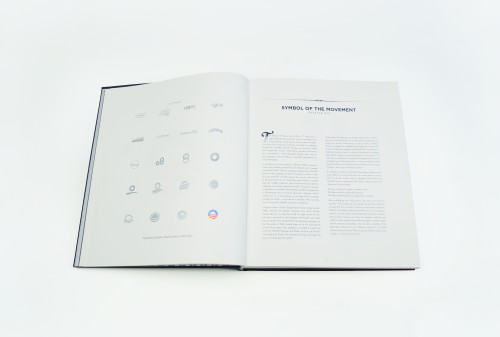
Designing Obama
Post Press, Chicago, 2010
Description
Project brief: Designing Obama was a unique project created to mark a moment in history for a community rather than for a publishing industry. Turning to self-publishing, we sought to produce a highly crafted artifact, rather than a mass-produced product. Kickstarter offered a new way of fundraising independent projects that focused on patronage instead of investing. Bringing Designing Obama and its $65,000 goal to Kickstarter marked a turning point for the website. Unlike other projects, it was grand in its scope and funding goal. This was not to be a small-run publication but a professional case-bound book featuring the voices of Steven Heller, Michael Bierut and the American people. If individuals could fund a legitimate publication, they would establish a new method of communication outside of the publishing industry’s vernacular.
Backing the project on Kickstarter not only bought you the product but also brought that product into existence if it met its financial goal. Our initial target audience was those who inspired and participated in the election. Through social media, we reached a greater international audience interested not only in Barack Obama but also in design, branding, art and politics. Much like the campaign, the book was funded by grassroots supporters who believed in its message. The backers of this project, along with friends, family, an editor and a printer formed the team that made Designing Obama possible.
Approach: After Designing Obama was successfully funded we began writing, designing the layout, contacting artists, looking for a printer and evaluating costs. Written by the design director of Barack Obama’s 2008 presidential campaign, this book provided insight into the design and branding of an unconventional candidate. The physical elements of a publication—from the printed word to the turn of a page—tell a story and offer an opportunity for design. Like its content, the physical book needed to be carefully crafted. The production process was explained to Kickstarter backers through photographs and videos, showing their support at work.
Six months after the project began, the finished 336-page hardbound volume arrived. We delivered books to our backers, made a few friends at the United States Postal Service and began distributing copies to the general public on Amazon and Designing-Obama.com.
So much of the production coincided with the campaign itself: from the grassroots supporters on Kickstarter that funded the project to the collaborative effort that helped assemble, design and proofread the book’s contents to the overall approach, which opposed traditional means of publishing. This book was crafted by the people for the people and represents the creative potential of collective action.
Effectiveness: The overall effectiveness did not come from the book itself but from the process of creating it. Like President Obama’s campaign, this book showed how collective action is more powerful than traditional, profit-motivated ways of getting things done. The process of independently designing, writing and publishing a book illustrated the power of the individual to create on their own terms. Designing Obama was the highest-funded project of its time, raising a total of $84,613. It propelled Kickstarter from hosting small projects to large-scale, state-of-the art projects. It raised the bar for quality, size and scale, inspiring Craig Mod, Nick Disabato, Frank Chimero and Scott Wilson (who raised more than $900,000) to bring their big ideas to life. Backers no longer had just purchasing power; they had a vote that decided what objects would exist in the world. Kickstarter began as a way for people to support a garage band’s first album, and stands today as a way for people to support an award-winning film director’s next feature-length film. This is the story of Designing Obama: when we work together, remarkable things can happen.
Juror Notes
We’re fighting over it.
Credits
- Design firm
- Post Press, Chicago
- Designer
- Scott Thomas
- Production coordinator
- Fabra DiPaolo
- Editor
- Mia Sara Bruch
- Writers
- Michael Bierut, Steven Heller
- Publisher
- Post Press
- Author
- Scott Thomas
- Producer
- Scott Thomas
- Printer
- Capital Offset
- Binder
- Acme Bookbinding
- Paper
- Sappi Galerie Art, text, silk
- Typefaces
- Claude Garamond, Hoefler & Frere-Jones, Robert Slimbach


